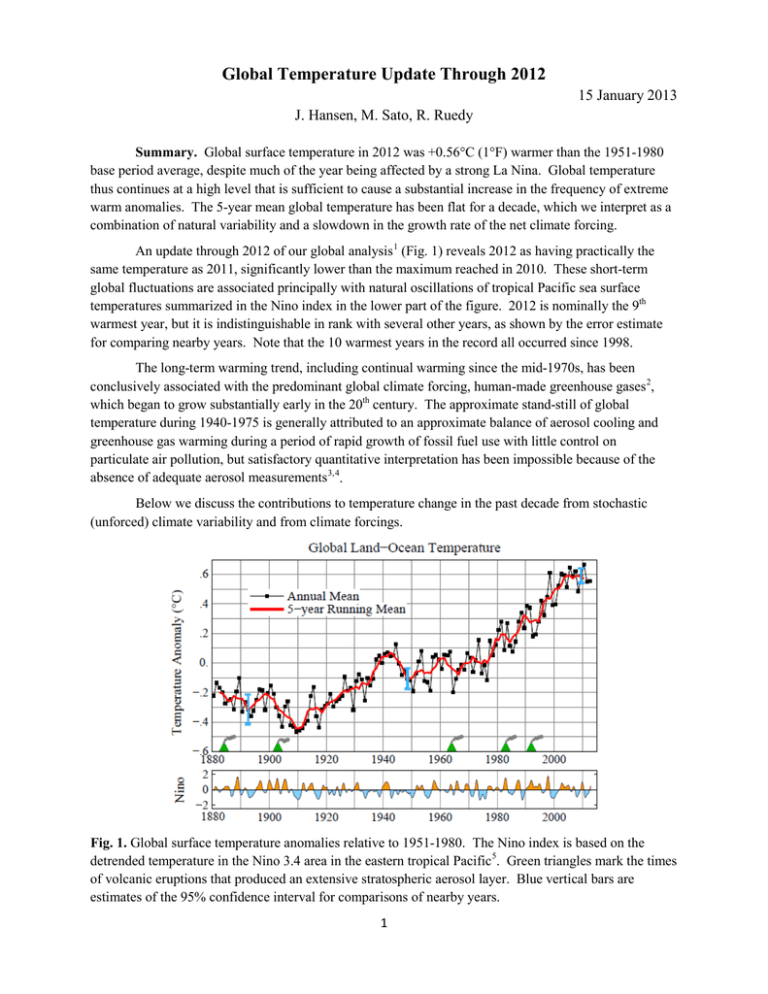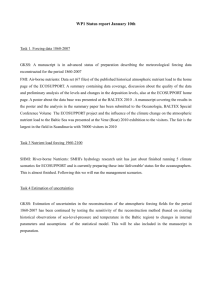Global Temperature Update Through 2012 15 January 2013
advertisement

Global Temperature Update Through 2012 15 January 2013 J. Hansen, M. Sato, R. Ruedy Summary. Global surface temperature in 2012 was +0.56°C (1°F) warmer than the 1951-1980 base period average, despite much of the year being affected by a strong La Nina. Global temperature thus continues at a high level that is sufficient to cause a substantial increase in the frequency of extreme warm anomalies. The 5-year mean global temperature has been flat for a decade, which we interpret as a combination of natural variability and a slowdown in the growth rate of the net climate forcing. An update through 2012 of our global analysis 1 (Fig. 1) reveals 2012 as having practically the same temperature as 2011, significantly lower than the maximum reached in 2010. These short-term global fluctuations are associated principally with natural oscillations of tropical Pacific sea surface temperatures summarized in the Nino index in the lower part of the figure. 2012 is nominally the 9th warmest year, but it is indistinguishable in rank with several other years, as shown by the error estimate for comparing nearby years. Note that the 10 warmest years in the record all occurred since 1998. The long-term warming trend, including continual warming since the mid-1970s, has been conclusively associated with the predominant global climate forcing, human-made greenhouse gases 2, which began to grow substantially early in the 20th century. The approximate stand-still of global temperature during 1940-1975 is generally attributed to an approximate balance of aerosol cooling and greenhouse gas warming during a period of rapid growth of fossil fuel use with little control on particulate air pollution, but satisfactory quantitative interpretation has been impossible because of the absence of adequate aerosol measurements3,4. Below we discuss the contributions to temperature change in the past decade from stochastic (unforced) climate variability and from climate forcings. Fig. 1. Global surface temperature anomalies relative to 1951-1980. The Nino index is based on the detrended temperature in the Nino 3.4 area in the eastern tropical Pacific5. Green triangles mark the times of volcanic eruptions that produced an extensive stratospheric aerosol layer. Blue vertical bars are estimates of the 95% confidence interval for comparisons of nearby years. 1 Fig. 2. Annual and seasonal temperature anomalies relative to 1951-1980 base period. Dec-Jan-Feb map employs December 2011 data, while the annual map is for calendar year 2012. The most extreme temperature anomalies in 2012, exceeding 2.5°C (4.5°F) on annual mean, occurred in the Arctic and in the middle of North America (Fig. 2). The large springtime heat anomaly in North America dried out the soil in a large part of the United States, thus leaving little soil moisture to provide evaporative cooling in the summer. The summer temperature anomaly was smaller than in the prior two seasons, but summer temperature variability is smaller than in the other seasons, so the 2012 summer anomaly was also unusually large as described in NOAA reports 6. 2 Fig. 3. Frequency of occurrence of local June-July-August temperature anomalies (relative to 1951-1980 mean) for Northern Hemisphere land in units of local standard deviation (horizontal axis). Temperature anomalies in 1951-1980 match closely the normal distribution (green curve), which is used to define cold (blue), typical (white) and hot (red) seasons, each with probability 33.3%. Lower graphs use only a subset of stations (1886 of 6147) that were present throughout recent decades as well as the base period. The New Climate Dice. The high current global temperature is sufficient to have a noticeable effect on the frequency of occurrence of extreme warm anomalies. The left-most "bell curve" in Fig. 3 is the frequency distribution of summer-average temperature anomalies during the base period 1951-1980, in units of the local standard deviation1 of seasonal-average temperature. The observational data show that the frequency of unusually warm anomalies has been increasing decade by decade over the past three decades. Perhaps the most important change is the emergence of extremely hot outliers, defined as anomalies exceeding 3 standard deviations. Such extreme summer heat anomalies occurred in 2010 over a large region in Eastern Europe including Moscow, in 2011 in Oklahoma, Texas and Northern Mexico, and in 2012 in the United States in part of the central Rockies and Great Plains. The location of these extreme anomalies is dependent upon variable meteorological patterns, but the decade-by-decade movement of the bell curve to the right, and the emergence of an increased number of extreme warm anomalies, is an expression of increasing global warming. Some seasons continue to be unusually cool even by the standard of average 1951-1980 climate, but the "climate dice" are now sufficiently loaded that an observant person should notice that unusually warm seasons are occurring much more frequently than they did a few decades earlier. 1 The standard deviation is a measure of typical variability about the average. About two-thirds of the cases fall within 1 standard deviation of the average and about 95 percent fall within 2 standard deviations. 3 Fig. 4. Top: Solar irradiance from composite of several satellite-measured time series. Data through 2 February 2011 is from Frohlich and Lean (1998 and Physikalisch Meteorologisches Observatorium Davos, World Radiation Center). Update is from University of Colorado Solar Radiation & Climate Experiment normalized to match means over the final 12 months of the Frohlich and Lean data. Sunspot data from http://sidc.oma.be/sunspot-data/ Global Warming Standstill. The 5-year running mean of global temperature has been flat for the past decade. It should be noted that the "standstill" temperature is at a much higher level than existed at any year in the prior decade except for the single year 1998, which had the strongest El Nino of the century. However, the standstill has led to a widespread assertion that "global warming has stopped". Examination of this matter requires consideration of the principal climate forcing mechanisms that can drive climate change and the effects of stochastic (unforced) climate variability. The climate forcing2 most often cited as a likely natural cause of global temperature change is solar variability. The sun's irradiance began to be measured precisely from satellites in the late 1970s, thus quantifying well the variation of solar energy reaching Earth (Fig. 4). The irradiance change associated with the 10-13 year sunspot cycle is about 0.1%. Given the ~240 W/m2 of solar energy absorbed by Earth, this solar cycle variation is about 1/4 W/m2 averaged over the planet. Although it is too early to know whether the maximum of the present solar cycle has been reached, the recent prolonged solar minimum assures that there is a recent downward trend in decadal solar irradiance, which may be a decrease of the order of 0.1 W/m2. Although several hypotheses have been made for how the solar irradiance variations could be magnified by indirect effects, no convincing confirmation of indirect forcings has been found except for a very small amplifying effect via changes of stratospheric ozone. 2 A climate forcing is an imposed perturbation of the planet's energy balance that would tend to alter global temperature. 4 Fig. 5. Update 7 of 5-year mean of the growth rate of climate forcing by well-mixed greenhouse gases; ozone and stratospheric water vapor, neither well-mixed nor well-measured, are not included. The largest climate forcing is caused by increasing greenhouse gases, principally CO2 (Fig. 5). The annual increment in the greenhouse gas forcing (Fig. 5) has declined from about 0.05 W/m2 in the 1980s to about 0.035 W/m2 in recent years 8. The decline is primarily a consequence of successful phaseout of ozone-depleting gases and reduction of the growth rate of methane. Also, the airborne fraction of fossil fuel CO2 emissions has declined and the forcing per CO2 increment declines slowly as CO2 increases due to partial saturation of absorption bands, so the CO2 forcing growth rate has been steady despite the rapid growth of fossil fuel emissions. The second largest human-made forcing is probably atmospheric aerosols, although the aerosol forcing is extremely uncertain3,4. Our comparison of the various forcings (Fig. 6a) shows the aerosol forcing estimated by Hansen et al.9 up to 1990; for later dates it assumes that the aerosol forcing increment is half as large as the greenhouse gas forcing but opposite in sign. This aerosol forcing can be described as an educated guess. If the aerosol forcing has thusly become more negative in the past decade, the sum of the known climate forcings has little net change in the past few decades (Fig. 6b). The increased (negative) aerosol forcing is plausible, given the increased global use of coal during this period, but the indicated quantification is arbitrary, given the absence of aerosol measurements of the needed accuracy. Even if the aerosol forcing has remained unchanged in the past decade, the dashed line in Fig. 6b shows that the total climate forcing increased at a slower rate in the past decade than in the prior three decades. The slight growth in the past decade is due to a combination of factors: solar irradiance decline, slight increase of stratospheric aerosols, and the lower growth rate of greenhouse gas forcing compared with the 1970s and 1980s. A slower growth rate of the net climate forcing may have contributed to the standstill of global temperature in the past decade, but it cannot explain the standstill, because it is known that the planet has been out of energy balance, more energy coming in from the sun than energy being radiated to space.10 The planetary energy imbalance is due largely to the increase of climate forcings in prior decades and the great thermal inertia of the ocean. The more important factor in the standstill is probably unforced dynamical variability, essentially climatic "noise". 5 Fig. 6. Estimated climate forcings, with uncertainties that vary from small for well-mixed greenhouse gases to large for unmeasured tropsopheric aerosols. Forcings through 2003 (vertical line) are the same as used by Hansen et al. (2007), except the tropospheric aerosol forcing after 1990 is approximated as -0.5 times the GHG forcing. Aerosol forcing includes all aerosol effects, including indirect effects on clouds and snow albedo. GHGs include O3 and stratospheric H2O, in addition to well-mixed GHGs. Indeed, the current stand-still of the 5-year running mean global temperature may be largely a consequence of the fact that the first half of the past 10 years had predominately El Nino conditions, while the second half had predominately La Nina conditions (Nino index in Fig. 1). Comparing the global temperature at the time of the most recent three La Ninas (1999-2000, 2008, and 2011-2012), it is apparent that global temperature has continued to rise between recent years of comparable tropical temperature, indeed, at a rate of warming similar to that of the previous three decades. We conclude that background global warming is continuing, consistent with the known planetary energy imbalance, even though it is likely that the slowdown in climate forcing growth rate contributed to the recent apparent standstill in global temperature. Climate Change Expectations. It is relevant to comment on expectations about near-term climate change, especially because it seems likely that solar irradiance observations are in the process of confirming that solar irradiance has weakened modestly over the latest solar cycle. If solar irradiance were the dominant drive of climate change that most global warming contrarians believe, then a global cooling trend might be expected. On the contrary, however, the continuing planetary energy imbalance and the rapid increase of CO2 emissions from fossil fuel use assure that global warming will continue on decadal time scales. Moreover, our interpretation of the larger role of unforced variability in temperature change of the past decade, suggests that global temperature will rise significantly in the next few years as the tropics moves inevitably into the next El Nino phase. The one major wild card in projections of future climate change is the unmeasured climate forcing due to aerosol changes and their effects on clouds. Anecdotal information indicates that particulate air pollution has increased in regions with increasing coal burning, but assessment of the climate forcing requires global measurement of detailed physical properties of the aerosols. The one satellite mission that was capable of making measurements with the required detail and accuracy was lost via a launch failure, and as yet there are no plans for a replacement mission with the needed capabilities.4 6 References 1 Hansen, J., Ruedy, R., Sato, M., Lo, K., Global surface temperature change, Rev. Geophys. 48, RG4004, 2010. Intergovernmental Panel on Climate Change, Climate Change 2007: The Physical Science Basis, eds. S. Solomon, et al., Cambridge Univ. Press, New York, 2007. 3 Hansen, J., Storms of My Grandchildren, Bloomsbury, New York, 304 pp., 2009. 4 Mishchenko, M.I., et al., Accurate monitoring of terrestrial aerosols and total solar irradiance, Bull. Amer. Meteorol. Soc., May, 677-691, 2007 5 Philander, S.G., Our Affair with El Nino: How We Transformed an Enchanting Peruvian Current into a Global Climate Hazard, Princeton Univ. Press, Princeton, NJ, 288 pp., 2006. 6 http://www.climatewatch.noaa.gov/article/2012/summer-2012-recap & http://www.ncdc.noaa.gov/sotc/ 7 Hansen, J. Sato, M., Greenhouse gas growth rates, Proc. Natl. Acad. Sci. 101, 16109-16114, 2004. 8 Hansen, J., Sato, M., Ruedy, R., Lacis, A., Oinas, V., Global warming in the twenty-first century:an alternative scenario, Proc. Natl. Acad. Sci. 97, 9875-9880. 2000. 9 Hansen, J.,Sato, M., Ruedy, R., Kharecha, P., Lacis, A., Miller, R., Nazarenko, L., Lo, K., Schmidt, G.A., Russell, G., et al., Dangerous human-made interference with climate: a GISS modelE study, Atmos. Chem. Phys. 7, 22872312, 2007. 10 Hansen, J., Sato, M., Kharecha, P., von Schuckmann, K., Earth's energy imbalance and implications, Atmos. Chem. Phys., 11, 13421-13449, 2011. 2 7


